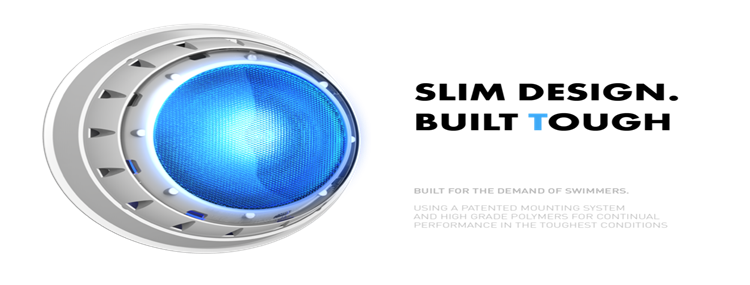Swimming Pool Lighting

Lighting for swimming pools
Enjoying your pool should not be just a daytime thing.
Installing underwater pool lights allows you to swim safely and enjoy your recreation time in the pool at night.
What Lights Are Available
Underwater lights are available in two styles:
- Surface mounted lights which are installed on the side of the pool wall.
- Flush mounted lights, commonly known as a niche, which are installed inside the pool wall and expose only the face plate of the light. These underwater lights that are flush-mounted are becoming much more popular with new pools
Both styles are easily fitted in either concrete or fibreglass pools. Vinyl pools are slightly different. Your choice will be limited to the surface mounted light and only a couple of brands of flush mounted lights.
Halogen v Light Emitting Diode (LED)
You will need to decide whether the pool light internals should be a Halogen globe or a LED.
Light Emitted Diode (LED)
A LED does not require changing and generally will last for many years. They draw little power which is an advantage. However, when the life of the LED light has finished, you may need to buy a whole new light. It’s recommended you check how many hours of burn time you should expect from your LED light, although most manufacturers state a life of 50,000 hours. LED lights are also rapidly taking over traditional halogen lights due to power costs and efficiency.
Halogen Lights
Halogen lights require globe changing, and the life is sufficiently shorter than a LED. The advantage is you will only need to replace the globe, not the whole light. The Halogen Light does a great job and is a cheaper choice if money is a problem. The disadvantage is that a 100 W Halogen light will draw 75 percent more power than a LED light.
Information To Be Aware Of When Choosing Lights
- 1 All underwater lights require a waterproof rating of IPX8, and new installations must not exceed 12V A/C or 30V D/C.
- 2 Your light must be water cooled at all times. It must never be turned on unless it is completely submerged in water otherwise damage will occur.
- 3 Cable size and cable length affect voltage. Extending or reducing supplied cable lengths can alter the performance of the light.
- 4 Always ensure your lights are positioned, installed and accessible, leaving enough cable length behind the light for ease of servicing. The depth of the light should be between 30 and 40 cms from the top of the coping.
- 5 Use your pool light at least 15 minutes per week; this will help in removing any excess moisture within the light cavity and increases the longevity of your globe.
- 6 Safety for swimmers at night should be taken into consideration when positioning your lights. Seek advice from the underwater light manufacturer or your chosen builder.
- 7 ALWAYS HIRE A LICENSED ELECTRICIAN FOR INSTALLATION!

